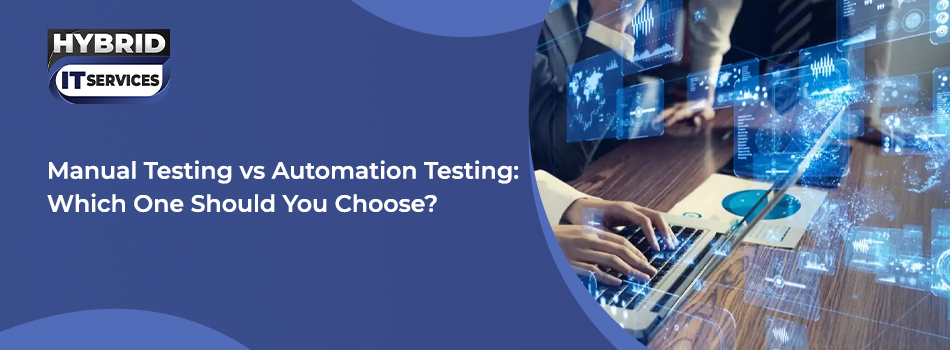Deciding between manual testing and automation testing might be difficult. But once you know the strengths, weaknesses, and best applications for both, you can make a decision more easily. In this blog, we at Hybrid IT Services give a detailed comparison of Manual Testing vs Automation Testing to assist you in deciding which type of testing you need for your particular project.
Manual Testing vs Automation Testing an Overview
Manual testing is particularly useful in those situations where human monitoring is required. In, for example, User Acceptance Testing (UAT), the manual testers verify whether the application is compliant with user requirements. since the tester is running the application in the same manner an end user will, the process catches errors that automated tools can't.
However, manual testing is not only time-consuming and drudgery but also prone to human error. It can also be too lengthy, especially in the context of big applications.
What is Automation Testing?
Automation is ideal for tasks that require repeated execution of test cases. It increases precision and test coverage, and hence, it is best for regression testing, performance testing, and large projects.
When to Use Automation Testing Over Manual Testing
- Repetitive and High-Volume Tests Automated testing is most useful if the same test cases have to be run repeatedly. It makes sure that everything remains consistent and also saves time while performing regression cycles.
- Greater Test Coverage With automation, you can run tests over many devices, browsers, and platforms at once. This is essential when creating software for a large user base.
- Quicker Feedback and Deployment Automation works in harmony with CI/CD pipelines so that faster feedback loops are possible and time to market is less. Bugs are found early, and fixes can be done more quickly.
- Resource Optimization With tests running continuously in the background, manual testers can now concentrate on intricate testing tasks that need human intuition and creativity.
- Sophisticated Test Scenarios Automated software can model complex scenarios such as biometric authentication, network environments, or high-volume data loads—test cases difficult to manually simulate.
Read the detailed related blog: Complete Guide to Custom Mobile App Testing
Manual Testing vs Automation Testing – Key Differences
|
Criteria |
Manual Testing |
Automation Testing |
|
Execution |
Performed manually by human testers |
Executed using scripts and automation tools |
|
Speed |
Slower due to human involvement |
Faster, tests run in minutes |
|
Cost |
Lower initial cost but higher long-term costs |
Higher upfront cost but cost-effective long term |
|
Accuracy |
Prone to human error |
Highly accurate once scripts are stable |
|
Reusability |
Test cases must be re-executing manually each time |
Test scripts can be reused multiple times |
|
Scalability |
Difficult to scale |
Easily scalable |
|
Ideal Use Cases |
Usability, exploratory, ad-hoc, one-time testing |
Regression, load, performance, repeated testing |
|
Reporting |
Manual reports via documents like Excel or Word |
Automated reporting within testing platforms |
|
Team Skills Required |
Domain knowledge and analytical thinking |
Programming knowledge and tool expertise required |
Manual Testing Instead of Automation When to Use It
- Complicated User Interactions Manual testing is best suited for analyzing user experience and interfaces. For example, how user-friendly is the design? Are fonts and colours uniform? These are subjective aspects that require human intelligence.
- Exploratory Testing Manual testing allows testers to explore the application freely, find edge cases, and discover hidden bugs that would never be detected using scripted tests.
- Short-Term Projects If the software is going to be used or tested once or for a brief time, then setting up automation costs and time might not be worth it.
- Appropriate resources automatically test calls for technical expertise. For non-technical teams without any automation testing tools, manual testing is always an expedient choice.
- In early development stages UI and behaviour keep changing very often. Usually testing needs alteration on short notice. Manual testing has no issues with such alteration.
Common Scenarios for Each Approach
Use Automation Testing When:
• Performing regression tests after every release
• Validating APIs with multiple input/output combinations
• Running performance or load tests
• Testing large data sets
• Integrating into DevOps and CI/CD pipelines
Use Manual Testing When:
• Conducting exploratory testing
• Evaluating the user interface
• Performing accessibility testing
• Validating language and localization
• Testing one-time or rare scenarios
• You have a large, complex application
• You require fast releases but can’t compromise on UX
• You follow Agile or DevOps practices
Can Automation Testing Replace Manual Testing?
While automation testing is faster and more efficient, it cannot completely substitute manual testing. Compare automation to a fast car and walking as manual. The car will get you there quickly, but you still require a driver.
Automated tests run according to scripts, yet actual situations usually include user actions unpredictable to scripts. Thus, both approaches provide the most accurate and comprehensive testing solution when used together.
Manual vs Automation What Do You Choose?
There isn't one right answer. Your decision should rely on:
• The size and type of your project
• Budget and schedule constraints
• Available skills and resources of your team
• Short-term vs long-term objectives
Best Practice: Leverage automation for repetitive, data-driven, or high-volume testing. Employ manual testing for exploratory, UI, or innovative testing. A hybrid strategy usually prevails.
Conclusion
Both automation testing and manual testing are fundamental columns of an effective QA plan. While manual provides human ingenuity and adaptability, automation provides scalability, homogeneity, and speed.
We at Hybrid IT Services assist companies in designing and deploying customized testing frameworks with the best of both worlds. In the delivery of a mobile application, website, or enterprise application, our aim is to make your product bug-free, intuitive, and ready to take over the marketplace. Consult now to design a smarter test strategy for your company!






